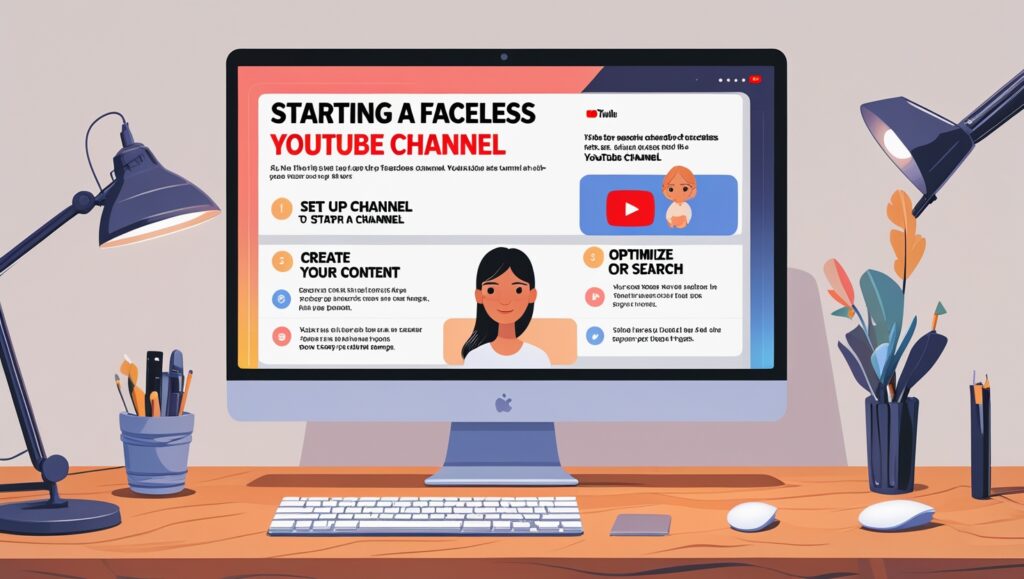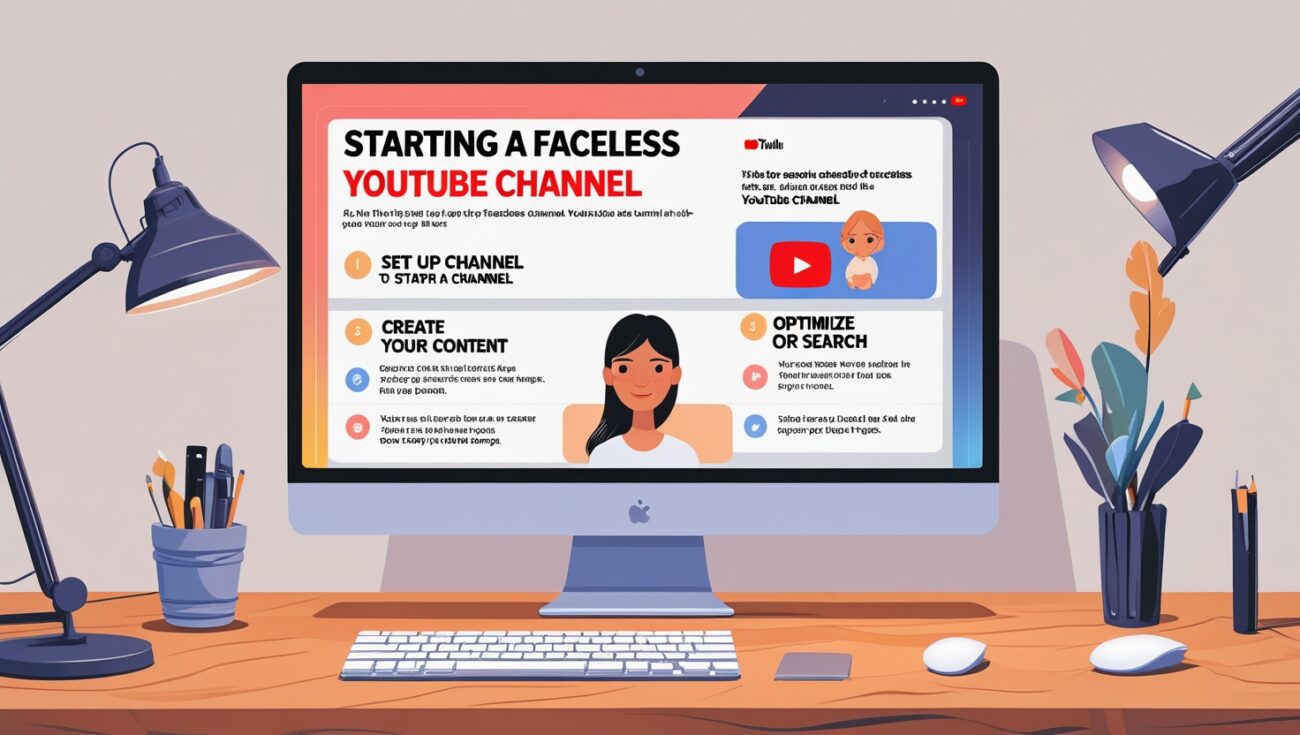Step‑by‑Step Guide to Starting a Faceless YouTube Channel
Want to start a YouTube channel without showing your face or using your own voice? This step-by-step guide walks you through the exact process I used to build a faceless channel using AI tools, voice generators, and simple editing—perfect for beginners who want to stay anonymous and still grow.

Table of Contents
Starting a YouTube channel felt impossible at first. I didn’t want to be on camera, I didn’t have editing experience, and I wasn’t about to spend thousands on equipment. But I had a message to share—and a goal to build automated income.
So I built everything from scratch with no camera, no mic, and no expensive software. If you’re in the same position, this is the exact blueprint I followed to create a faceless YouTube channel that earns and grows on its own.
Step 1: Choose the Right Niche
Before anything else, I picked a niche that had high search volume, low competition, and long-term interest.
I wasn’t chasing trends—I was building something evergreen.
Here are a few niches that work great for faceless channels:
- Productivity & motivation
- Personal finance & investing
- AI tools & tech reviews
- Health tips & storytelling
- Business ideas & digital income
Use YouTube’s search bar, Google Trends, and TubeBuddy to validate your topic before you start creating.
Step 2: Write Your First Script
This step used to feel overwhelming—until I discovered AI script tools.
I now use AI to generate video scripts in minutes. Sometimes I just feed it a video title and let it build the outline. Then I tweak the script so it sounds like me.
The goal isn’t to make it perfect. The goal is to make it clear, helpful, and human.
Step 3: Use an AI Voice Generator (This One Changed Everything)
I didn’t want to record my own voice. But I also didn’t want my videos to sound robotic.
So I tested multiple text-to-speech tools until I found ElevenLabs.
This tool creates realistic, human-sounding AI voiceovers with emotion, tone, and pacing that actually feels natural.
I use ElevenLabs in every single video I create—and it’s the only reason I was able to launch my channel so quickly without speaking into a mic.
Step 4: Add Visuals and Edit the Video
For visuals, I use tools like Pictory or CapCut to match footage to my script and voiceover.
These tools pull stock video, add transitions, and sync audio automatically. No advanced editing needed.
Sometimes I’ll drop in screenshots, quotes, or animations depending on the niche—but everything starts with that clean voiceover from ElevenLabs.
Step 5: Upload and Optimize for SEO
Your video title, thumbnail, and description matter a lot.
I use TubeBuddy to find keywords, write SEO titles, and craft descriptions that rank.
Each video includes:
- An SEO-rich title
- A thumbnail made in Canva
- A description with relevant keywords and affiliate links (like ElevenLabs)
This is how I drive traffic and revenue at the same time.
Step 6: Monetize and Repeat the Process
Once you have 5–10 videos live, the YouTube algorithm starts to notice.
But you don’t need to wait for AdSense to make money. I started monetizing with affiliate links right away—especially when I showed people how I was using tools like ElevenLabs.
Every video I publish becomes a mini funnel—bringing in views, traffic, and clicks day after day.
Final Thoughts
If you’ve been thinking about launching a YouTube channel but don’t want to be on camera—don’t wait.
This step-by-step system works, and I’m living proof of it.
You don’t need to be a celebrity. You need consistency, good tools, and a little patience.
Start with your voice generator, because that’s what your audience hears first.
Click here to try ElevenLabs and start your faceless channel the way I did—simple, anonymous, and scalable:
When I published my first video, I had zero editing skills and zero subscribers. What I did have was a system. Once I used ElevenLabs to generate a clean voiceover, everything else became easier. I wasn’t stuck trying to re-record messy audio or fix microphone issues—I could focus on getting my message out.
What surprised me most is how people reacted to the voice. They assumed it was me. That’s how real the ElevenLabs voices sound. The tone, pacing, and emotion are on point. And when people trust the voice, they trust the message—and they stay longer. That’s a win for both audience retention and the algorithm.
I also noticed that once I had a few good videos out, YouTube started showing my channel more. It wasn’t overnight, but it felt like each video stacked on the next. With a repeatable workflow using ElevenLabs and Pictory, I was able to publish faster without sacrificing quality.
A lot of creators burn out because they overcomplicate everything. What helped me stay consistent was cutting out the noise. I stuck with a handful of tools that I knew worked—ChatGPT for scripts, ElevenLabs for voice, CapCut for editing. That’s all I needed to grow without showing my face.
There’s something powerful about creating content without being tied to your appearance. I’ve been able to build a brand that runs on value, not vanity. And the more I improve the voice and script quality, the more viewers I attract—because they’re listening, not judging.
One strategy that worked well for me was turning one video idea into multiple formats. I’d create the main YouTube video, then use the ElevenLabs voiceover to repurpose it into a podcast intro, a short-form video, or even a Pinterest pin with narration. That kind of content stacking is only possible when you have reusable assets.
I didn’t start with confidence—I built it by taking action. The moment I stopped worrying about what I looked or sounded like, I started publishing. And once the clicks and comments came in, I knew I was on the right track. AI didn’t replace me—it empowered me.
There’s no need to fake a voice or try to sound like someone else. With ElevenLabs, you can choose a tone that fits your niche. I use one voice for my tech videos and another for storytelling content. That flexibility lets me speak to different audiences while keeping everything automated.
Once I started linking tools I actually use in my descriptions, I noticed a steady flow of affiliate clicks. People wanted to know how I made the content, so I showed them. That’s why ElevenLabs is always at the top of my description—it’s what powers my entire channel.
Your first video doesn’t need to be perfect. Mine wasn’t. But with every video, I got faster. I learned what worked. And once I had a format I liked, I just repeated it. That’s the real key—consistency over perfection. AI helps you do that without burning out.
If you want long-term success, you have to think like a system builder. Set up your workflow once, then let the tools do their job. I batch scripts, generate all voiceovers in ElevenLabs in one sitting, and schedule uploads ahead of time. That gives me freedom while still growing my channel.
I get why people hesitate. It feels risky to start something new. But here’s what I’ve learned: taking action beats waiting for confidence. And with tools like ElevenLabs, you don’t have to be perfect—you just have to start.

